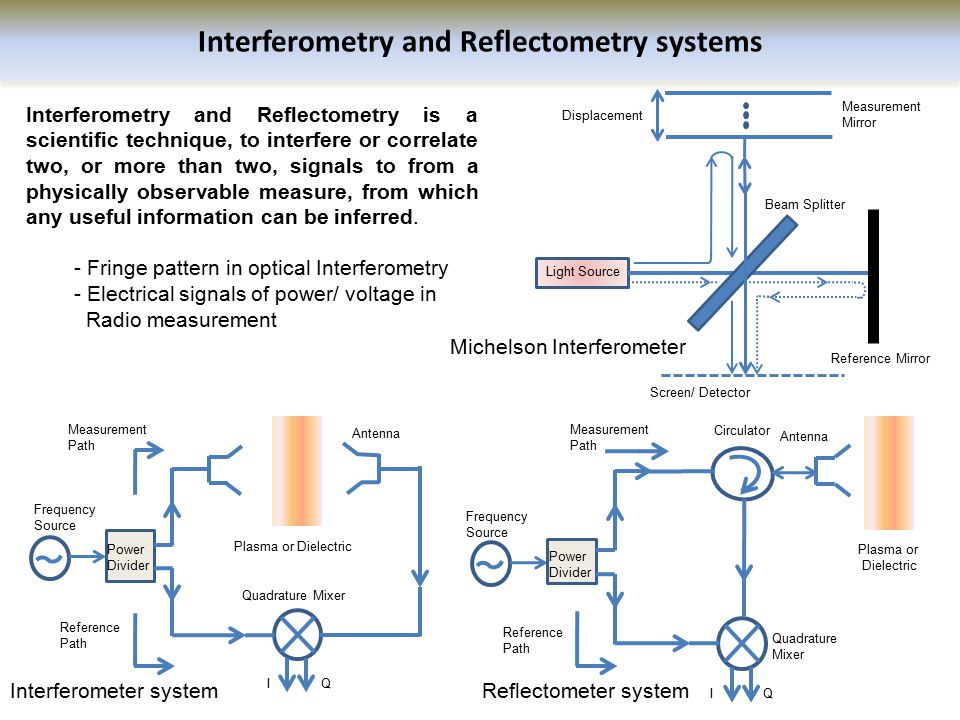A Reliable Millimeter-Wave Quadrature Interferometer
M. Gilmore, W. Gekelman, K. Reiling, and W.A. Peebles
Institute of Plasma and Fusion Research, University of California, Los Angeles, California 90024
A
simple, low-cost millimeter-wave (70 GHz) interferometer with a phase
accuracy better than ± 2 degrees, and a response time of 10 ns is
described. The simplicity of this interferometer makes it ideal for
measurement of electron densities in laboratory or semiconductor
processing plasmas. The relative high accuracy and low cost are attained
by a homodyne system with a quadrature intermediate frequency (IF)
mixer, now commercially available in millimeter-wave frequency bands.
The design and construction of magnetic shielding for the system
isolator, which may be required around magnetically-confined plasmas, is
also described.

1. INTRODUCTION
Although Langmuir probes are able to measure normalized density profiles, they are unreliable for determining absolute density in the presence of strong (B > 500 Gauss) magnetic fields. Comparison of the density from either the electron or ion saturation currents can be a factor of three lower than densities derived from wave dispersion. In applications where the absolute density needs to be known an alternative technique must be employed. The measurement of wave dispersion is time consuming, however microwave interferometry can be an attractive alternative.
Many interferometry applications, such as the measurement of electron densities ne = 1017-1018 m-3 in plasmas ranging in size from a few centimeters (cm) to many tens of cm, are best handled at millimeter-wave frequencies. Typically, millimeter-wave interferometers have been either rather low resolution homodyne systems, more complicated frequency modulated homodyne systems [1], or high resolution heterodyne systems which are relatively expensive to construct [2]. In unmodulated homodyne systems utilizing a mixer with a single IF output, the output voltage is VIF = Acos(theta) Here A is the amplitude and q is the phase angle between the radio frequency (RF) and local oscillator (LO) inputs. Generally VIF is a function of both phase angle and RF power. Thus, there is ambiguity between amplitude and phase changes, and the user must resort to counting the number of 2 pi phase shifts (fringes), and estimating fractions of a fringe. Additionally, there is no information available from the interferometer as to whether the phase difference is increasing or decreasing. This can be a problem, for example, in plasmas that initially increase in density, and drop before reaching steady state.
The problems of amplitude-phase ambiguity and phase uncertainty can be solved by frequency modulation (FM) of the source of a homodyne interferometer. A changing plasma density appears as a time varying phase shift in the IF signal. While effective, this approach adds to the complexity and cost of the system, and can potentially add phase noise and drifts. In addition, the frequency response of the instrument is limited by the modulation frequency ( f = 1 MHz).
A
simple solution to the problems encountered in these type of homodyne
instruments, without resorting to a heterodyne system, is to generate
two IF outputs in phase quadrature, VIF1 = Asin(theta) and VIF2 = Acos(theta). One output can then be divided by the second, yielding a result containing phase information only.
VIF1/VIF2 = tan(theta) (1)
Although other designs are possible [3],[4], the most direct way to generate phase quadrature outputs is to use a commercially available quadrature IF mixer. A description of the implementation and operating characteristics of a 70 GHz quadrature homodyne system utilizing a packaged quadrature mixer is the subject of this paper. This system combines high sensitivity with fast time response, superior to that of an FM homodyne system, at low cost. In addition, the simplicity of the instrument provides a high level of reliability.